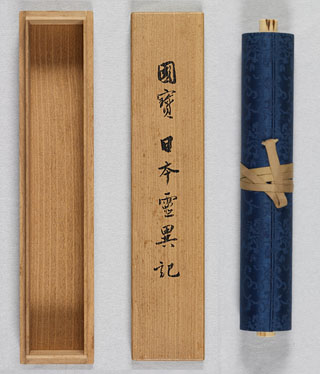The Kofukuji manuscript of the Nihon ryoiki (Record of Supernatural and Strange Matters in Japan)
The Nihon ryoiki(Scroll 1) Form of the Scroll 29.6cm×870.0cm
The Nihon ryoiki, also read Nihon reiiki, is considered the earliest collection of Japanese setsuwa, which are brief tales that often created for purposes of moral education. This first fascicle of the collection is mounted as a single scroll that measures 29.6 cm. in height and is 870 cm. in length. The full title of the work is Nihon koku genpo zen'aku ryoiki (Record of the Supernatural and Strange Tales of the Compensation of Good and Evil in the Country of Japan). It was compiled during Konin era (810-824) by the Buddhist monk Kyokai, who had abandoned secular life to become a monk at Yakushiji temple. The collection is composed of three fascicles and contains 116 tales. The Kofukuji manuscript was discovered in 1922 (Taisho 11) amidst the ruins of the To-Kondo (Eastern Golden Hall) of the temple. Only the first fascicle of the work is extant, but it contains the copying date Engi 4 (904), and as the earliest copy it has been designated a National Treasure. The manuscript has only been available in a photographic facsimile edition published in 1934 (Showa 9) by Benrido, and that publication itself has become a rare edition. Judging from the intrusion into the 19th tale of the Nihon ryoiki of annotations from the Zhongjing yaoji jinzang-lun (Jp. Sh?kyo yosh? kin'zoron), which is now on the reverse, the side with this Buddhist scripture was originally the face of the manuscript, and thus the Nihon ryoiki appears to have been copied later on the back of the scripture. At some time in the past the scroll was re-rolled in reverse fashion so the Nihon ryoiki appeared on the face. The fact that first portion of the scroll shows considerable abrasion and there are paper patches, over which characters have been re-written, pasted at the 30th tale indicate that this manuscript of the Nihon ryoiki was frequently read. The Nihon ryoiki illustrates the theory of cause and effect that had been developed in India and absorbed into Buddhism, as does the Jinzang lun. The titles of individual tales in the Nihon ryoiki all indicate that the events depicted therein are the result of a "causal condition" (縁 Jp. en, Ch. yuan), suggesting that it is more than coincidence that the two works were written on front and back of the same manuscript.
Shukyo yoshu konzoron(Spine・Scroll 6・parts)
A portion of the 6th fascicle of the Zhongjing yaoji jinzang-lun (Jp. Shukyo yoshu konzoron), a collection of tales that appear in various Buddhist scriptures which were then classified and compiled by the Buddhist monk Daoji in China at the close of the Northern Dynasties (first half of the 6th century), appears on the reverse of the Nihon ryoiki. The entire work, which is thought to have been composed of either seven or nine fascicles, has not survived, but the Kofukuji manuscript of the sixth fascicle and two scrolls, fascicles one and two, in the possession of the Museum of Otani University, which were originally the property of Horyuji, give some sense of the original work. Moreover, the fact that fascicles five and six of the Jinzang-lun have been discovered among the sutras at Dunhuang in recent years has attracted a great deal of attention. The tales that are included in the collection frequently take the form of recounting the primary cause (因 Jpn. in, Ch. yin) from the past that results in an effect (Jp. ka , Ch. guo) in the present. The first story in the Kofukuji manuscript tells of man who from the time of his birth is covered by a canopy of jewels, and it becomes clear that this is the result of his having fashioned a canopy of jewels to cover a pagoda in a past life. The principle that cause and effect are concomitant, i.e. good causes produce good results and bad causes produce bad results, is clearly illustrated in these stories, and thus the intent of the compilation appears to have been to lead people to Buddhism. The 1934 photographic reproduction of the Nihon ryoiki contains only two photographs of the Jinzang-lun (one from the beginning and the other from the end of the scroll).
※" Assistant professor Motoi Makiko of Tsukuba University assisted with the commentary and interpretation of the Jinzang-lun.

The Kofukuji manuscript of the Nihon ryoiki Box, Form of the Scroll (composite))